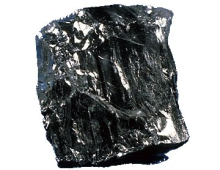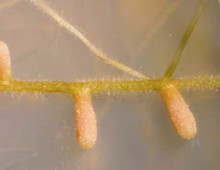A Rotten Coaltastrophe
Much of the world’s coal was generated 300-360 million years ago, during an era known as the Carboniferous period. But it may have come to an end from an unlikely source: fungus. An international team of scientists, including researchers at Clark University and the U.S. Department of Energy Joint Genome Institute (DOE JGI), has proposed… [Read More]
Some Enzymes Like it Hot
It sounds like a dream vacation: hang out in hot springs all day, converting sugar to alcohol. But that’s precisely what researchers are looking for in microbes to more efficiently break down plant matter into fermentable sugars for biofuel. And they found it in Dictyoglomus turgidum, in samples from Obsidian Hot Spring in Yellowstone National… [Read More]
Protein studies offer clues on how palm worms can take the heat
Hydrothermal vents behave like geysers at a national park, except that they erupt deep underwater in the Pacific and Atlantic Oceans. Though the water that shoots out of these vents can reach temperatures as high as 300°C (572°F), many animals and other organisms thrive in the surrounding area. Two such extremophiles are “palm worms,” named… [Read More]
Comparative genomics method to tag novel nitrogen-fixation genes
Nitrogen is crucial for plant growth but plants cannot harness it directly from the atmosphere. In the United States, legume crops such as soybeans and peas rely on nitrogen fertilizers to boost yields; in 2007, 13 million tons of industrially-produced fertilizers were applied. Soil bacteria such as Sinorhizobiummeliloti have a symbiotic relationship with plant hosts… [Read More]
Lessons from the adaptive strategies of a fungal pathogen
by ressaure Coniferous forests in Europe and North America have suffered several hundred million dollars in damages annually from the fungal pathogen Heterobasidion annosum. Aside from the economic losses, scientists are concerned by the white rot fungus that not only breaks down the wood for nutrients, but also releases the carbon dioxide trapped in the… [Read More]
Foxtail Millet Genome an Improved Reference for Switchgrass
The DOE is interested in switchgrass as a prospective biofuels feedstock, but its genome is complicated because it has multiple copies of its chromosomes. As the world leader in sequencing plants and other organisms for their relevance to DOE missions, the JGI has sequenced switchgrass and several other plants that are candidate plant feedstocks; other… [Read More]
Microbes as the unknown variable in thawing permafrost
Permafrost covers a quarter of the Earth’s land surface and stores significant amounts of carbon. As global temperatures rise and cause the frozen soils to thaw, so have concerns on the fate of the stored carbon and on the global climate. One of the recent studies that looked at this question was conducted by researchers… [Read More]
Overcoming short-read genome sequence assembly challenges
The genome assembly challenges posed by short sequence reads from sequencing platforms such as 454/Roche and Illumina are well-documented; the lack of reference genome data can hinder attempts to put together the myriad of short DNA sequences. Researchers from the Georgia Institute of Technology and the DOE JGI wanted to determine the impact of short… [Read More]
An alternative surrogate for gene discovery in switchgrass
Selected for the DOE JGI 2007 Community Sequencing Program because of traits such as high yield, perennial growth and low nutrient requirements, switchgrass is a promising candidate bioenergy crop that could be used to develop cellulosic biofuels. One of the challenges with sequencing switchgrass is the fact that it is a polyploid, containing multiple, full… [Read More]



